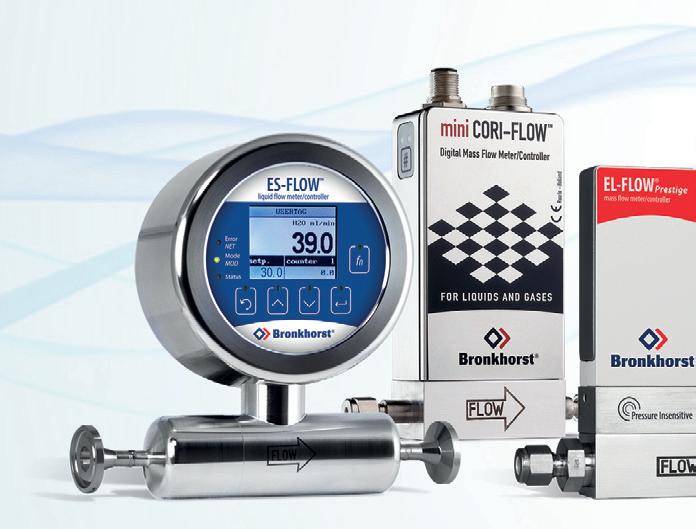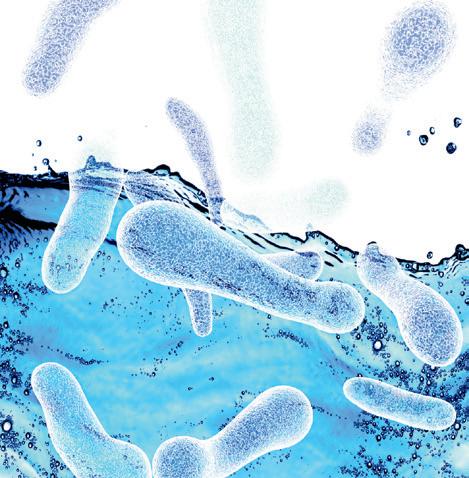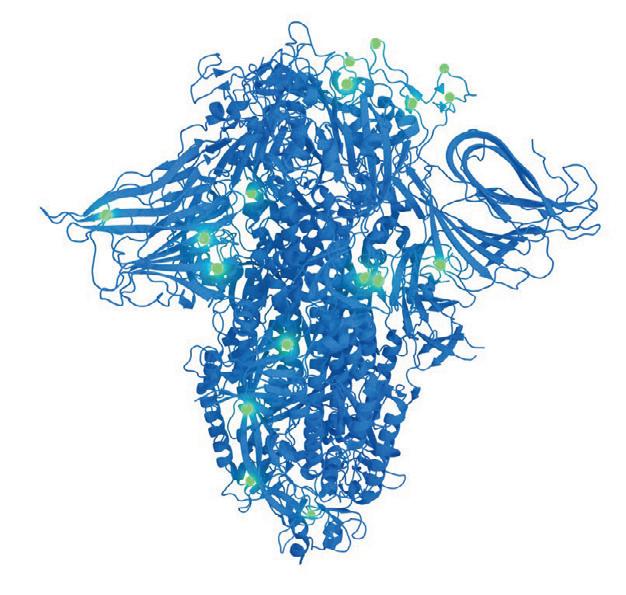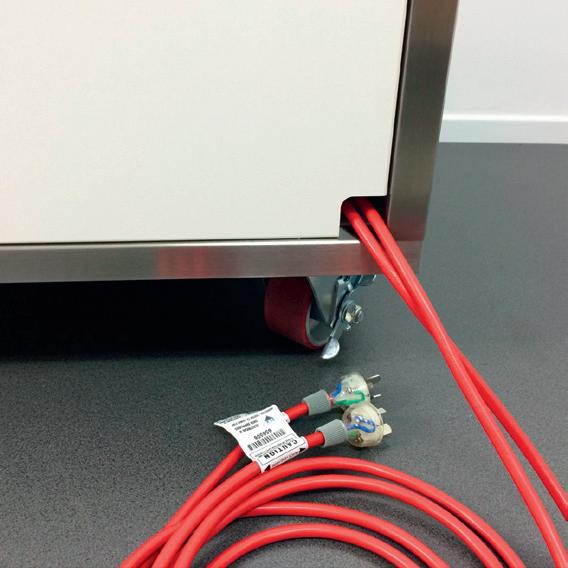
17 minute read
THE ANTIBIOTIC POTENTIAL OF CBD
©stock.adobe.com/au/HQUALITY
Researchers from The University of Queensland’s (UQ) Institute for Molecular Bioscience and Botanix Pharmaceuticals have shown that synthetic cannabidiol — better known as CBD — can kill the bacteria responsible for gonorrhoea, meningitis and Legionnaires’ disease, in a breakthrough that could lead to the first new class of antibiotics for resistant bacteria in 60 years.
UQ Associate Professor Mark Blaskovich said CBD — the main non-psychoactive component of cannabis — can penetrate and kill a wide range of bacteria including Neisseria gonorrhoeae, which causes gonorrhoea. In Australia, gonorrhoea is the second most common sexually transmitted infection and there is no longer a single reliable antibiotic to treat it because the bacteria is particularly good at developing resistance.
“This is the first time CBD has been shown to kill some types of gram-negative bacteria,” Dr Blaskovich said. “These bacteria have an extra outer membrane, an additional line of defence that makes it harder for antibiotics to penetrate.”
The team’s study, published in the journal Communications Biology, also showed that CBD was widely effective against a much larger number of gram-positive bacteria than previously known, including antibiotic-resistant pathogens such as MRSA (methicillin-resistant Staphylococcus aureus) or ‘golden staph’. Dr Blaskovich said CBD was particularly good at breaking down biofilms — the slimy build-up of bacteria, such as dental plaque on the surface of teeth — which help bacteria such as MRSA survive antibiotic treatments.
Dr Blaskovich said his team at the Centre for Superbug Solutions mimicked a two-week patient treatment in laboratory models to see how fast the bacteria mutated to try to outwit CBD’s killing power. He said, “Cannabidiol showed a low tendency to cause resistance in bacteria even when we sped up potential development by increasing concentrations of the antibiotic during ‘treatment’.
“We think that cannabidiol kills bacteria by bursting their outer cell membranes, but we don’t know yet exactly how it does that, and need to do further research.”
Additionally, the team discovered that chemical analogues — created by slightly changing CBD’s molecular structure — were also active against the bacteria. Dr Blaskovich said this is “particularly exciting because there have been no new molecular classes of antibiotics for gramnegative infections discovered and approved since the 1960s, and we can now consider designing new analogues of CBD within improved properties”.
Vince Ippolito, President and Executive Chairman of Botanix, said the research showed vast potential for the use of synthetic CBDs as antimicrobials. “Our company is now primed to commercialise viable antimicrobial treatments which we hope will reach more patients in the near future,” he said. “This is a major breakthrough that the world needs now.”
Dr Blaskovich said collaborating with Botanix has sped up the research, with Botanix contributing formulation expertise that has led to the discovery that how CBD is delivered makes a huge difference in its effectiveness at killing bacteria. The collaboration has also enabled Botanix to progress a topical CBD formulation into clinical trials for decolonisation of MRSA before surgery.
“Those Phase 2a clinical results are expected early this year and we hope that this will pave the way forward for treatments for gonorrhoea, meningitis and Legionnaires’ disease,” Dr Blaskovich said.
“Now we have established that cannabidiol is effective against these gram-negative bacteria, we are looking at its mode of action, improving its activity and finding other similar molecules to open up the way for a new class of antibiotics.”


Cell lines for chromatin research
CellBank Australia has released two cell lines for the study of chromatin architecture and dynamics. The HeLa derivatives are genetically modified to carry fluorescently tagged histone H2B proteins. H2B is a core component of the nucleosome, where it plays an important role in transcriptional regulation, DNA repair and other essential cellular functions.
The first cell line, HeLa H2B-GFP, carries H2B tagged with eGFP. The second cell line, HeLa H2B-GFP, carries both a H2B tagged with eGFP and H2B tagged with mCherry. Expression of both proteins enabled study of chromatin compaction in live cells using FLIM-FRET microscopy.
The cell lines were published in PNAS in 2019, where they were used to study the remodelling of chromatin architecture at double-strand break sites during DNA repair.
CellBank Australia www.cellbankaustralia.com

Nanoparticle size and concentration analysis
The Zetasizer Advance family of light-scattering instruments offer the versatility to deliver fast and comprehensive particle size analysis. Combining novel measurement capabilities together with an artificial intelligence (AI)-led approach to data quality assessment, the Zetasizer systems are designed to help gain more insight and further confidence to characterise size and surface charge of colloids and biomolecular nanoparticles; screen protein formulations for colloidal stability and the presence of aggregates; and assess the shelf life and stability of complex formulations.
Building on the legacy of the Zetasizer Nano series, the three core models — Zetasizer Lab, Zetasizer Pro and Zetasizer Ultra — can be tailored and quickly upgraded to suit specific application needs. The Zetasizer Advance range offers particle size (from below 1 nm to 10 µm), particle charge (zeta potential) and particle concentration analysis. In addition, each benefits from the below advances.
A data acquisition algorithm, featuring adaptive correlation, uses a statistically driven approach to produce the best correlation data, without the need for sample filtering, to deliver fast size measurements and add confidence to the results. Multi-angle dynamic light scattering (MADLS) meanwhile enables calibration-free measurement of particle concentration.
Novel constant current zeta mode allows for high ionic strength measurements previously not achievable. Improved zeta sensitivity requires much lower sample concentrations for a zeta measurement, saving precious material.
AI-guided data quality advice allows even a novice without any prior light scattering knowledge to make sense of sizing data. A novel 3 µL low-volume size cell lowers sample volume and extends concentration range.
A fluorescence filter wheel allows for extended applications with fluorescent samples, like quantum dots. Polarisation filter as well as vertical and horizontal polarisation components can be detected, potentially offering insights into particle rotational diffusion.
There are more than 100,000 publications using the Zetasizer. The product also works with OmniTrust, Malvern Panalytical’s compliance solution for the regulated environment.
ATA Scientific Pty Ltd www.atascientific.com.au
Liquid diaphragm pump
The Rocker Alligator is a compact liquid diaphragm pump that is used to transfer liquid directly to waste or a drain. ISO 8199 compliant, the product meets regulations for water quality microbiological examinations by culture.
The product is suitable for microbiological and general filtration. The compact design removes the need for excess tubing and waste bottle, making the device useful for small laboratories with limited bench space.
The pump operates at a maximum vacuum of 313 mbar and has a flow rate of 4.5 L/min. Safety features include a built-in thermal protection device and IP64 protection.
Labtek www.labtek.com.au

Acoustic liquid handler
The Beckman Coulter Life Sciences Echo 525 acoustic liquid handler is a modern platform for tipless small-volume dispensing that is designed for use in biochemistry and genomics applications. Liquid transfer is achieved via acoustic droplet ejection (ADE), which uses focused ultrasonic energy to eject small droplets of a defined volume (25 nL for the Echo 525) from a source well into a destination well. This allows rapid, precise liquid transfer at nanolitre to microlitre scales while avoiding tip-based crosscontamination and reducing plastic waste.
The product can assemble a full 384-well plate of qPCR reactions in less than 10 min and is thus suitable for high-throughput qPCR reaction set-up. Luna qPCR reagents from NEB are compatible with Echo-mediated acoustic transfer and maintain sensitive detection and linear quantitation in 384-well format at reduced reaction volumes. In addition, using the Luna Cell Ready One Step RT-qPCR Kit, Beckman Coulter Life Sciences presents a convenient workflow for automated direct RTqPCR analysis of cell samples, with cell culture and lysis in Echo-qualified source plates providing transfer-ready template lysates for ADE-mediated reaction assembly and high-throughput RT-qPCR analysis.
Beckman Coulter Australia www.beckman.com.au
PROTECTING BIOPHARMA MANUFACTURING... ALL NEW PURE-GARD
sANITARy PREssURE RELIEF

• PURE-GARD FOR CLEANABILITy - CREVICE AND DIMPLE FREE DEsIGN • PURE-GARD FOR sTRUCTURAL sTABILITy - ONE PIECE AssEMBLy PROTECTs THE DIsC - ALLOWs FOR MINOR PIPE MIsALIGNMENT • PURE-GARD FOR EXTENDED PRODUCT LIFE - ALLOWs FOR REGULAR GAsKET CHANGEs • PURE-GARD Is TAG FREE - ALL TECHNICAL DETAILs ETCHED ON BODy • PURE-GARD HAs OPTIONAL BURsT DETECTION PURE-GARD: 1”–4” Ø 40 – 300 psig PURE-GARD SOLO: 1”–8” Ø 18 – 75 psig


aUSTraLIaN aGENT & TEChNICaL SUPPOrT We handle Pressure ®
Tel: (03) 9699 7355
9504P&SSP harma
COVID-19: 6 challenges to large-scale testing

Designing and manufacturing lab instruments that include automated liquid handling is challenging at the best of times, but in the face of increased demand for faster testing, it’s even more critical to select the right partner and reliable components. The global COVID-19 pandemic is posing unprecedented challenges for laboratories as they race to meet the demand for accurate, large-scale testing in a short amount of time, and without the risk of cross-contamination.
These requirements all point to the heart of the test instrument — the pump. Automated liquid handling instruments are only as reliable as the components that they are comprised of — and when process hygiene comes into play, it’s the pump that leads the way in orchestrating that all factors of process security are met. For a pump to do its job under these extreme circumstances, six process capability challenges have to be overcome. Unprecedented pressure on liquid handling capability in the lab Large-scale diagnostic testing is widely regarded as a key tool in epidemiology and in containing outbreaks such as COVID-19. No surprise, then, that experts including the Harvard Global Health Institute are calling for a massive scale-up in COVID-19 testing as part of measures to prevent new outbreaks. High-throughput, sequencingbased diagnostic tests are playing a central role in meeting that capacity.
The healthcare industry, including the clinical diagnostics sector, has been responding as quickly as it can with its pandemic preparedness. Harvard University recently published a document on ‘Pandemic Resilience’ describing the need for fast scale-up of multiple levels of testing in order to control the pandemic. The European Centre for Disease Prevention and Control has noted that once rapid commercial SARS-CoV-2 diagnostics tests are validated to have adequate performance for infection detection, additional capacity for much-largerscale testing will be necessary to meet the operational needs for COVID-19 control in the forthcoming months.
This massive level of scaling up requires absolute confidence in testing equipment. Many labs may be unaware that the choice of pump is critical for liquid handling operations, which is why OEM providers must take this into account. That means surmounting a range of potential obstacles that can threaten process reliability — at a time when labs can least afford it.
Ensuring a pandemic-proof testing process by choosing the right pump Achieving an accurate, reproducible and contamination-free environment for viral work comes down to how much control a lab has over its process — and whether the pump is robust enough to meet demands. Although the end user may not be aware of it, pumps and other liquidhandling components in their manual or automated processes play a critical part in success… or failure. Here are six key challenges that viral research and testing labs are facing. 1. Poor liquid-handling performance Poor liquid handling can adversely affect the quality of sample transfer. Performance must be monitored continuously to detect the liquid level at all times, correctly dispense liquid, and avoid errors that can lead to a precious loss of time, sample, reagent, effort and money. This comes down to having a robust design in the pipetting drive mechanism. 2. Lack of precision Imprecision can lead to inaccurate test results. It inhibits repeatability and reproducibility, which are essential to large-scale testing. Because manual sample prep is prone to human error, automated pipetting instrumentation can help eliminate this challenge. 3. Cross-contamination Cross-contamination can affect confidence in the results for any tests. A highly sensitive detection process requires sound manufacturing and lab practices when assembling testing kits and running diagnostic testing.
4. Need for high-throughput assays and scalability Without high-throughput COVID-19 diagnostic tests, it is difficult to achieve the additional capacity necessary for large-scale testing. Consider scaleup and avoid test instruments with inherent test limits. 5. Need for automated instruments Minimising manual handling, for example with automated pipettes, reduces potential crosscontamination and inaccuracies. “Automated sample prep is a critical component of the overall set-up, in part because manual sample prep is prone to error and not easily scalable,” notes Tim Hodge, Director of Operations at University Clinical Health, a commercial lab in Memphis, Tennessee, in a recent article on scale-up for COVID-19 testing. This is echoed by Melissa Miller, Director of the clinical molecular microbiology lab in the University of North Carolina Hospital system, who said in the same article, “We would not be able to survive without automation right now. The volume of testing has steadily increased weekly, and to have the capacity we need to serve our patients we rely on automation.” 6. Meeting stringent regulatory requirements Regulatory guidelines and approval processes can often change quickly and unexpectedly during a global health crisis, and can influence the pandemic preparedness of the health industry.
Reducing the risks of cross-contamination, which includes finding a pump that delivers precise, accurate and reproducible results, is of paramount importance in this urgent testing environment. Talk to a Tecan expert to learn more about how the choice of pump or pipette for COVID-19 testing can help labs attain pandemiclevel performance —
*David Wold is the Customer Operations Manager for the Partnering Business in the Components Marketing Team at Tecan.
This article has been republished with permission from Tecan.
Tecan Australia www.tecan.com





Legionella detection kit
The qualyfast DNA Extraction Kit, from Bioside, is a fast DNA extraction kit designed to detect Legionella in clear water samples. Extracted DNA can be directly used in downstream applications, including PCR and qPCR, without the need for further purification.
Commercial operations that have been closed for several weeks or even months are at a heightened risk of the waterborne pathogen Legionella. Slow-moving or stagnant water allows the bacteria, which can cause the highly contagious, atypical pneumonia Legionnaire’s disease, to multiply. Unused air-conditioning and cooling tower systems, many of which have been idle in recent months, pose a particular public health risk.
The qualyfast Legionella PCR range offers environmental testing laboratories a complete sample-to-answer workflow that can deliver results in hours rather than days, when compared to more conventional culture media-based methods. This enables laboratories to give businesses the all-clear for Legionella and help them to get back to work.
The kits, which are stable at room temperature, offer a simple and easy-to-use workflow including: water sample preparation to eliminate common environmental contaminant-driven false negatives; rapid and sensitive qPCR detection technology provided as pre-dosed and lyophilised reagents to enable confident identification or exclusion of Legionella species and Legionella pneumophila in samples; and quantification standards for reproducible test results.
Thermo Fisher Scientific thermofisher.com
LED widefield illumination system
Featuring eight individually controllable LEDs and ultrafast TTL switching, CoolLED’s pE-800 is a widefield illumination system that delivers high-quality data. Versatile and intuitive, the product features liquid light guide delivery, designed to make next-generation LED illumination accessible to all.
Eight individual analog inputs allow irradiance to be controlled from 0–100% for each channel via analog signal (0–10 V), which is suitable for electrophysiology and optogenetics applications. The system features <7 µs TTL triggering for live cell imaging. Capturing dynamic events is possible with high temporal resolution and even without software, due to precise hardware synchronisation via TTL input for each channel and compatibility with the pE-6501-8 (USB-controlled TTL conversion kit).
The ability to fit inline excitation filters capitalises on TTL trigger speeds, as single-band excitation filters can be installed for each channel. When used alongside multiband filters, eg, in a Pinkel configuration, this removes the need for external filter wheels and overcomes the latency restrictions of mechanical movement.
SciTech Pty Ltd www.scitech.com.au
Flow meter/controller
Bronkhorst presents the latest generation of ES-FLOW Ultrasonic Flow Meters for low flow rates of water, additives and other liquid substances. The improved flow meters are designed to measure volume flow from 2 up to 1500 mL/min with even higher precision, high linearity and low-pressure drop, using ultrasound in a small-bore tube.
The instruments are liquid-independent, due to a measuring principle in which the actual sound velocity is accounted for in the flow calculations. The combination of a straight sensor tube with zero dead volume means the flow meter is self-draining. The flow meter with orbital TIG-welded flanges is CIP or SIP cleanable, and now meets 3-A sanitary standards for hygienic applications. Wetted parts are made of stainless steel and the exterior design is rated to IP66 or IP67.
The local user interface is a capacitive touchscreen with a TFT display to operate and readout the instrument. For remote operation, Bronkhorst added a variety of Ethernet-based fieldbuses to the already available range of analog and digital communication options. The onboard PID controller can be used to drive a control valve or pump, enabling users to establish a complete, compact control loop. Typical applications for the low-flow liquid flow meters and controllers can be found in food, beverage and pharma (eg, additives, sterilisation of packages), medical and chemical (eg, catalysts, reagents), and many other markets that require precision fluid handling, such as fuel consumption measurement and dosing of hydrocarbons, demineralised water, colourants or lubricants in many industries.
AMS Instrumentation & Calibration Pty Ltd www.ams-ic.com.au

Recombinant SARS-CoV-2 spike mutants
Since emerging in 2019, SARS-CoV-2’s genome has proved to be relatively stable. However, the emergence of multiple new variants in late 2020 has caused concern over the efficacy of recently developed countermeasures, including diagnostics, therapeutics and vaccines. Many mutations have occurred in the Spike protein and its receptor-binding domain (RBD), which plays a central role in pathogenesis and the induction of neutralising antibodies. To support the investigation of SARS-CoV-2 variants, The Native Antigen Company offers a growing range of recombinant mutant spike antigens. Expressed from their proprietary mammalian expression system, these antigens display full glycosylation and proper folding for use in the development of high-performance assays and other applications.
Recombinant mutant antigens are available for the following SARS-CoV-2 lineages (spike mutations): European variant B1 (D614G); Scotland-1 (D614G, L84I, N439K); England-1 (D614G, S477N); England/Bristol-1 (D614G, V445I, H655Y, E583D); Australia-1 (D614G, G485R); Sweden-1 (D614G, E484K); and European Variant B1 (D614G).
Also available are a range of recombinant antigens for the spike mutations of the following SARS-CoV-2 lineages: UK Variant B.1.1.7; Brazilian Variant B1.1.24; B1.1.298; B1.1; B.1.258, B.1.141/B1.258; Spanish Variant B1.177; and South African Variant B.1.351 (501Y.V2).
BioNovus Life Sciences www.bionovuslifesciences.com.au


LabBench is constantly making improvements to its instrument benches, with a recent focus on user safety and equipment longevity.
The company’s polished stainless steel structure and laminated panels make for easy COVID sanitising. Benches are totally sanitised and immediately wrapped before dispatch. They are also pallet loaded for minimal handling with clear markings on sanitising dates. All panels and parts are interchangeable and replaceable, allowing for easy modification to suit new instruments or for miscellaneous replacement.
LabBench’s internal power cord containment and internal power distribution board mean that multiple instrument power cords remain internal to the bench; only the distribution board is plugged externally. Internal power distribution boards are fitted with residual current devices with overcurrent protection. These devices are ‘two pole’, keeping tabs on positive and neutral issues well before the instrument.
Adjustable, temperature-controlled cooling fans for vacuum pumps, with optional temperature warnings and smartphone application, take care of overheating within the integrated noise suppression chamber. Phone charging can also be incorporated into the bench.
Lab Bench www.labbench.com.au









